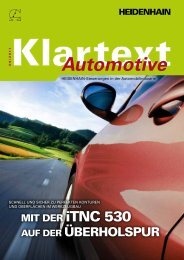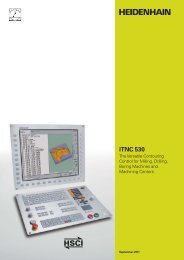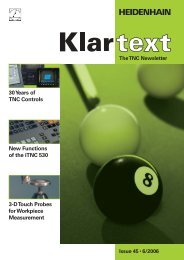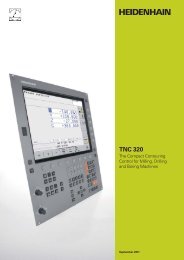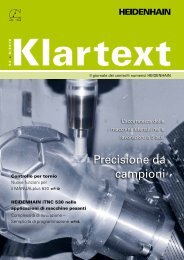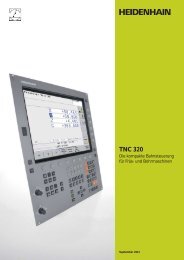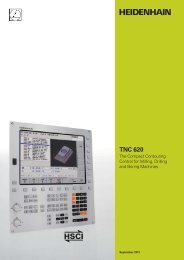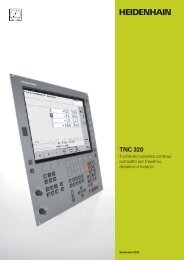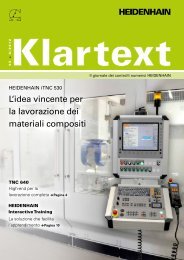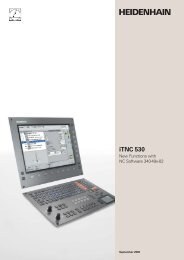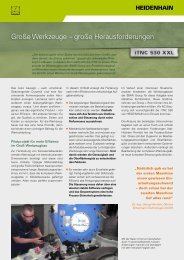Klartext 47 - TNC 640 - Heidenhain
Klartext 47 - TNC 640 - Heidenhain
Klartext 47 - TNC 640 - Heidenhain
You also want an ePaper? Increase the reach of your titles
YUMPU automatically turns print PDFs into web optimized ePapers that Google loves.
<strong>Klartext</strong> + Issue <strong>47</strong> + 09/2007<br />
How position capture should be<br />
realized on feed axes<br />
Velocity<br />
measurement<br />
Position<br />
measurement<br />
Such sources of errors can be prevented<br />
through the use of linear encoders,<br />
which enable thermal expansion of the<br />
ball screws to be fully compensated.<br />
The test shown in the figures clearly<br />
illustrates the thermal errors of machining<br />
without linear encoders.<br />
A coupling lever from aviation technology<br />
is milled from aluminum to a depth<br />
of 10 mm. After 20 air cycles above the<br />
workpiece, the lower part of the lever<br />
is milled. The thermal drift of the feed<br />
axis is visible by an edge on the side<br />
of the workpiece. If the machine has<br />
linear encoders, then no edge results<br />
in this test.<br />
A reproducible accuracy from the very<br />
first unit is guaranteed!<br />
Effects on mold and die making<br />
Mold and die making for milling places<br />
high demands on the form accuracy.<br />
At the same time, high feed rates are<br />
necessary in order to shorten machining<br />
times. The first and last milling<br />
paths must match, otherwise the time<br />
previously gained would be lost due<br />
to extensive reworking. The example<br />
shows a form machined to represent<br />
the profile of the Watzmann mountain.<br />
In order to visualize the linear deviation<br />
resulting on this mold component from<br />
operation without linear encoders, machining<br />
was deliberately begun in the<br />
middle of the workpiece. Start and end<br />
paths therefore lie side by side, and the<br />
edge clearly shows the thermal drift. If<br />
a machine tool with linear encoders is<br />
used, then the Watzmann profile does<br />
not show this edge.<br />
Coupling lever, processed twice from the same blank form<br />
Without linear encoders (left): Thermal drift is visible by the offset on the edge<br />
With linear encoders (right): No thermal drift visible<br />
Watzmann profile with free-formed surfaces:<br />
machined on the left without linear encoders,<br />
on the right with linear encoders<br />
Conclusion:<br />
Production orders are completed es-<br />
pecially successfully if the machine<br />
tools used feature a high degree of<br />
thermal stability. In this case the feed<br />
axes must achieve the required accuracy<br />
over the complete traverse range<br />
even with strongly varying speeds and<br />
machining forces. These targets can<br />
be met by using linear encoders on<br />
machine tools.<br />
At the HEIDENHAIN stand<br />
in Hall 25, Booth E18, you can<br />
see and feel the effects of such<br />
machining on the actual work-<br />
pieces described in this article.



